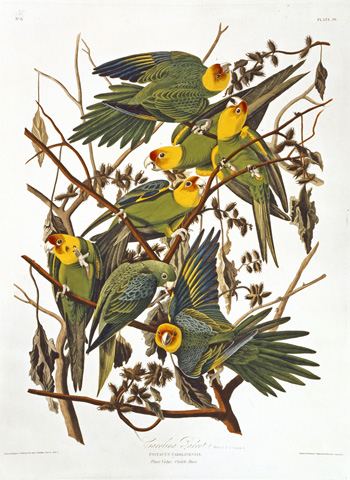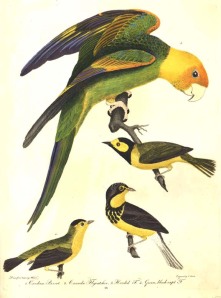The Carolina Parakeet
The Carolina Parakeet (Conuropsis carolinensis).

Length: 30cm (12in)
Description-
Adult: forehead, lores, area around eyes and upper cheeks orange; remainder of head, throat and upper part of neck yellow; outer webs of primaries marked yellow towards their base; bend of wing, carpal edge and thighs yellow; rest of plumage green, paler on underparts; bill horn-coloroured; legs and feet pinkish brown
The Carolina Parakeet was the only parrot species native to the eastern United States. It was found from southern New York and Wisconsin to the Gulf of Mexico, and lived in old forests along rivers.

Supposedly, flocks of Carolina Parakeets had such strong bonds that when some of their members were killed the remainder of the flock returned to their bodies repeatedly until all were shot. A flock would therefore inspect a feeding site carefully before landing.

Song: Loud quarrelsome screams given in flight
Behavior: Social and gregarious. Occurring in flocks except in breeding season when pairs nested in dense colonies. Mated for life. Roosted communally in hollow trees. Fed in bottomland forests, riverbanks, and cypress swamps on tree and grass seeds, thistle, fruits and berries.

Carolina Parakeets were probably poisonous—John James Audubon noted that cats apparently died from eating them, and they are known to have eaten the toxic seeds of cockleburs. As forests were cleared to make room for farmland, farmers would shoot them as they considered them pests. Flocks were plentiful in the 18th and 19th centuries. Audubon described a flock attacking grain in the fields: Flocks of these birds …cover them so entirely, that they present to the eye the same effect as if a brilliantly covered carpet had been thrown over them.

Parakeets were hunted for its feathers, particularly as decoration for ladies hats; the pet trade; for sport and as pests. No one knows when the last wild parakeet died; the last two parakeets in captivity lived together in the Cincinnati Zoo for thirty-two years. Lady Jane passed away in 1917 and her companion Incas passed in 1918, ironically in the same cage that the last known Passenger Pigeon, Martha, had passed away in four years earlier.
Rumors of their continued existence circulated for long afterwards. Bird enthusiasts claimed to have seen isolated examples deep in the Carolina swamps, most of which is also gone now, up until the 1930’s.

[…] The Carolina Parakeet (sarahnicholls.wordpress.com) […]